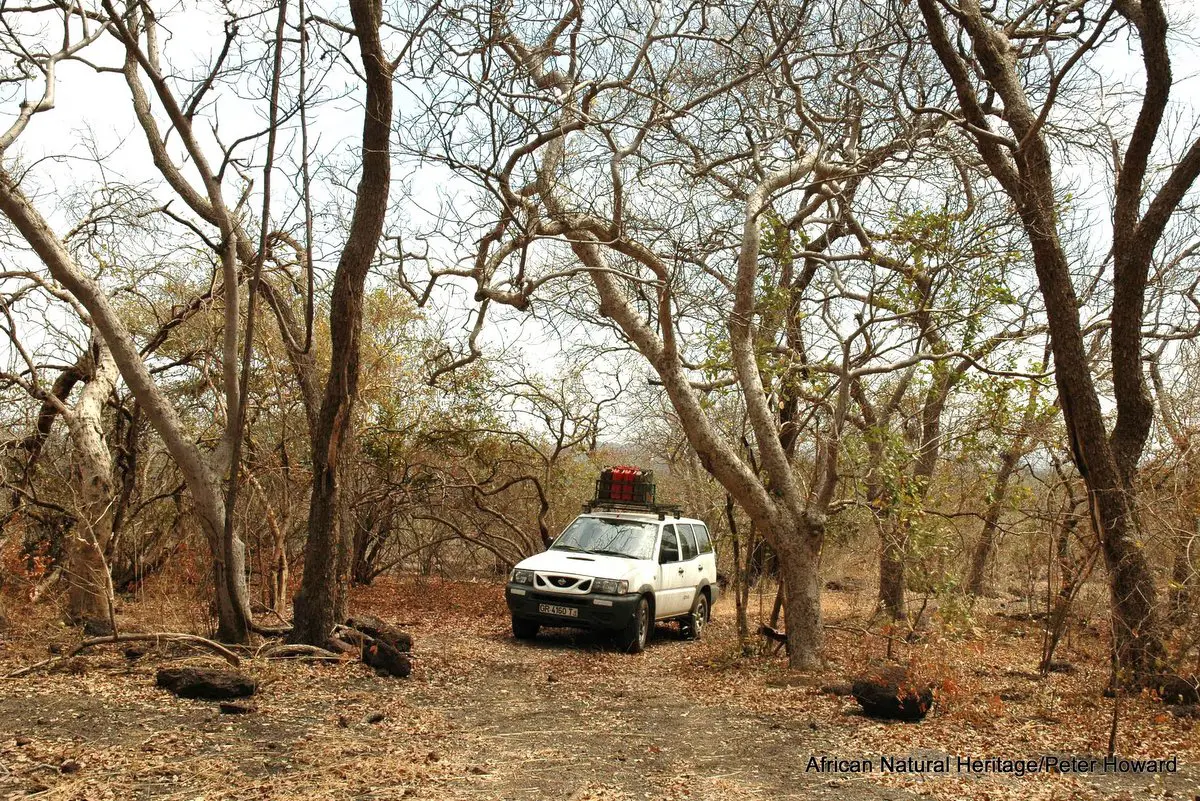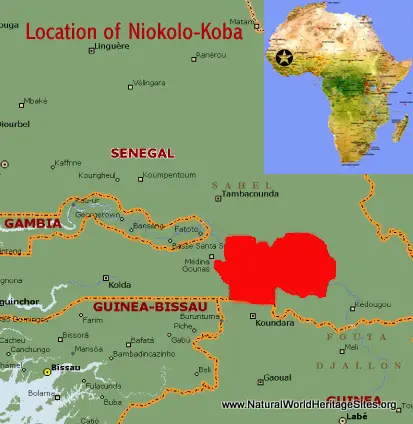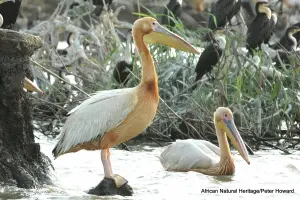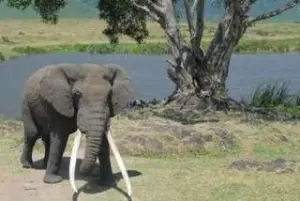EXPLORE SENEGAL’S NIOKOLO-KOBA NATIONAL PARK with this slideshow, check the location map and get all the facts and information below.
For slideshow description see right or scroll down (mobile). Click to view slideshow
Values: This is an extensive Guinea savanna woodland site, bordering the Gambia river, with a good variety of habitats, ranging in altitude from around 30 to 360 metres. A remnant population of Derby’s eland still exists, as well as a diversity of other fauna and flora, including distinct types (such as the Guinea baboon) that are restricted to the western part of west Africa.
The substantial populations of large mammals that existed at the time of listing, including all the giraffe, and most of the elephants have been lost to poaching.
A comprehensive review of the world heritage values of the site is provided below, together with details of the area’s conservation status and the threats it faces.
REVIEW OF WORLD HERITAGE VALUES: According to IUCN’s Conservation Outlook Assessment (2014), the specific attributes which qualify Niokolo-KobaNational Park for world heritage status can be summarised as follows:
Exceptionally diverse flora and fauna. The park has a remarkable diversity of flora and fauna, unique in the subregion. There are over 70 species of mammals, 329 species of birds, 36 species of reptiles, 20 species of amphibians and many invertebrates. Lions are a particular attraction (now extremely rare in West Africa), as are Giant (Derby’s) Eland, Africa’s largest antelope. Other important large mammal species include elephant, leopard, wild dog and chimpanzee. The flora of the park is also diverse with over 1,500 species of plants recorded.
High number of endemic sub-species and varieties. A large number of the park’s plants and animals are distinctive sub-species or varieties which used to be widespread across West Africa, but are now limited to a few remaining protected habitats in parks and reserves. Niokolo-Koba represents one of the most complete remaining natural ecosystems with a comprehensive assemblage of these unique forms.
Exceptional diversity of ecosystems characteristic of the Sudanese climatic zone. The Niokolo-KobaNational Park contains all the unique ecosystems of the Sudanese bioclimatic area including major rivers (the Gambia, Sereko, Niokolo, and Koulountou), gallery forests, flood plains, seasonally-inundated grasslands, freshwater swamps and ponds associated with old river ox-bow lakes, dense dry forests, rocky slopes and hills with patches of closed canopy forest.
CONSERVATION STATUS AND PROSPECTS: The park is on UNESCO’s List of World Heritage Sites In Danger because the main elements of the large mammal fauna are critically endangered or on the brink of extinction. However none of the large animals has been completely lost and populations of all the endangered species could be restored in the medium term if immediate protection of remaining individuals can be established. As well as implementing an effective anti-poaching regime, management needs to carry out regular animal census and ecological monitoring, deal with invasive species and develop more productive ways of engaging with local communities. The management authority lacks the necessary technical, administrative and financial resources to carry out its mandate and the national leadership seems to lack the necessary political will towards wildlife conservation.
MANAGEMENT EFFECTIVENESS: Protection of the park is facing many difficulties: management is weak with a high turnover of staff, and ineffective anti-poaching patrols covering little of the park’s area (due to lack of necessary vehicles and park infrastructure). The land outside the park is under heavy pressure from a growing human population for agriculture and a difficult relationship exists between the park authority and local communities.
REVIEW OF CONSERVATION ISSUES AND THREATS: The following issues represent specific threats to the ecology, conservation and values of Niokolo-KobaNational Park world heritage site.
Poaching. Commercial poaching appears to be the main threat to the park and seems widespread, particularly in the southwest area. The low density of animals in remote parts of the park (where rangers do not patrol) and the difficulty of sighting conspicuous large mammals such as Giant (Derby’s) Eland and Sable Antelope throughout the park seems to provide evidence of intensive poaching.
Agricultural encroachment. Some agricultural encroachment has occurred along the northern edge of the park as farmers seek new land to accommodate an expanding human population and compensate for declining soil fertility of lands already under cultivation. The problem of encroachment has been exacerbated by the consistent failure of patrol staff to address the issue and the poor state of boundary demarcation.
Grazing of domesticated animals. The park is subject to high levels of grazing pressure from cattle and other domestic stock which are driven into the park by members of neighbouring communities. Grazing pressure is particularly acute during the dry season when bush fires are started deliberately by herders to stimulate new growth, and floodplain grasslands within the park provide grazing at a time when grasslands elsewhere have been depleted or dried up.
Wood Harvesting. Palm trees provide a particularly important source of termite-resistant timber which is highly valued. This has been heavily harvested within the park, with particularly devastating impact in the western part of the park. As resources in the more accessible parts of the park have become depleted the threat of further illegal cutting has declined.
Fire. Fires are often started deliberately by cattle-keepers wanting to stimulate early-season grazing for their cattle, and by park management. There is however no fire management plan so the basis for deliberate management burning is not clear. It is probable that fires are destroying rare forested habitats on Mount Assirik and some gallery forests, while limiting the regeneration of woodlands.
Stone Quarrying. Two basalt quarries were established within the park to supply material for road construction nearby. These have subsequently been closed down, although it is not known whether the quarry sites have been rehabilitated.
Invasive Alien Species. Two invasive plant species (Mimosa and Mitrogena) are spreading prolifically throughout the seasonal ponds associated with old ox-bow lakes along the river floodplains. Little is known about the cause of their rapid spread, but they clearly represent a serious threat to the ecology of these critical habitats and the many species that depend on them.
Dam construction. A major dam is planned upstream of the park on the Sambangalou River (in Gambia). This is likely to impact the park in a number of ways by reducing the seasonal fluctuations in river levels along its entire course, affecting the riverine and floodplain habitats that depend on these seasonal changes. The most significant impact may be the elimination of flooding events which currently sustain the floodplains and their seasonal ponds, leading to encroachment of these areas by woody vegetation and loss of their critical role in providing dry-season grazing for wildlife. There are likely to be other impacts on park habitats, especially its rare gallery forests and palm groves.
Links:
Google Earth
UNEP-WCMC Site Description
IUCN Conservation Outlook
Official UNESCO Site Details
Birdlife IBA
Slideshow description
The slideshow provides a comprehensive overview of Senegal’s Niokolo-Koba National Park (officially designated by UNESCO as a World Heritage Site In Danger), showing the area’s wooded savanna landscapes, wildlife habitats, plants and animals. It highlights some of the conservation management issues, and illustrates local community livelihoods and some typical visitor experiences.
Factfile
Website Category: Tropical and Sub-tropical Savannas and Woodlands
Area: 9,130 km2
Inscribed: 1981
Criteria:
- (x) biodiversity





